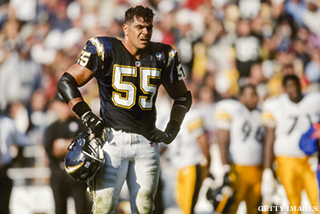
Junior Seau, certain Hall of Fame National Football League linebacker, was the essence of life force itself. From his days growing up in Oceanside, California, to All America status at USC and superstardom with the San Diego Chargers and later with the Dolphins and Patriots, he was a force of nature on and off the field.
Vibrant, fiery, emotional, charismatic -- a whirling dervish of energy and feeling. His multi-watt smile lit the world. When he extinguished his own flame last year, the sports world was shocked -- how was this possible? He had descended into a post-career world of heavy darkness -- depression and isolation, even though he could still wear the public mask of normalcy. Because of the courage of the Seau family in allowing his brain to be tested for damage, we now know he had descended into the behavioral pattern that ensues with chronic traumatic encephalopathy.
As I watched my star NFL clients endure concussion and head injuries during the past 40 years I knew intuitively that there had to be long-term consequences that we didn't know about. The problem was that the hits were just an accepted part of the game. As recently as 1994 the NFL was telling players that there was no proof that long-term damage was being caused by multiple head injuries or that one hit had a relationship to another.
I grew increasingly disturbed by the lack of knowledge of brain function and finally convened a series of Concussion and Player Safety Conferences in Southern California in the early 1990's. We had leading neurologists like Dr. Mark Lovell, Dr. Bob Cantu and Dr. Julian Bailes informing our clients on what was then known of the risks. We issued a white paper calling for a neurologist on the sideline, removal of the helmet-to-helmet hit from football, and a standardized regimen of diagnosis and mandatory sit-out periods. Not much changed.
Along with Dr. Tony Strickland and the Concussion Institute, I participated in another series of concussion seminars in Los Angeles starting in 2006. Knowledge of brain function had expanded. Researchers like Dr. Kevin Gusciwiecz presented findings that suggested that three or more concussions might be a trigger number and that the risk for Alzheimers, ALS, Parkinsons, premature senility and dementia increased exponentially at that level. There were findings that depression rates with multiple concussions increased by fourfold. I called this "an undiagnosed health epidemic" and a "ticking time bomb."
Commissioner Roger Goodell took a fresh look at the problem and convened a physician’s conference and issued a whistle-blower edict asking players to report others with impaired behavior on the field. The Berlin Wall of denial ended and the NFL adopted Dr. Lovell's IMPAACT baseline testing. Baseline establishes a player’s cognitive level before the season and after a concussive hit gives an objective framework to compare and then judge an appropriate time for return to play.

While the NFL is more aware, the challenges have risen. Contemporary players are bigger, stronger and faster and the physics and force of hits have amplified. Protective equipment has not proved effective. In Seau's day, concussions were not monitored so there is no way of knowing how many hits he had to the head. A concussion is not defined as being knocked out -- it is a blow to the head or body occasioning a change in brain function. Players suffer these blows on every play without them being acknowledged. The act of an offensive lineman hitting a defensive lineman on every play produces a low level concussive hit. A pro player who plays 10 seasons after college may potential have had 10,000 low level concussive hits -- what is the cumulative effect of that?
Cumulative hits can lead to chronic traumatic encephalopathy as it did with Chicago Bears safety Dave Duerson, Junior Seau, and many other players. In this syndrome, the player becomes depressed and withdrawn post-career. It seems to lead to loss of job, breakup of marriage, and in many cases suicide. We all are aware that playing the sport of football breaks down every joint in the body. Players from Pop Warner on are in a state of denial about their physical condition and long-term health. They want to play the next play whatever the consequences. They are stoic warriors. It is incumbent on coaches, trainers, families and agents to insist that they consider long-term health issues. I felt like an enabler, putting large amounts of money in player bankbooks while sending them into an activity that might destroy their capacity for a happy post-career life, which is why I felt the need to act.
-- Leigh Steinberg has represented many of the most successful athletes and coaches in football, basketball, baseball, hockey, boxing and golf, including the first overall pick in the NFL draft an unprecedented eight times, among more than 60 first-round selections. His clients have included Hall of Fame quarterbacks Steve Young, Troy Aikman and Warren Moon, and he served as the inspiration for the movie "Jerry Maguire." Follow him on Twitter @SteinbergSports.




